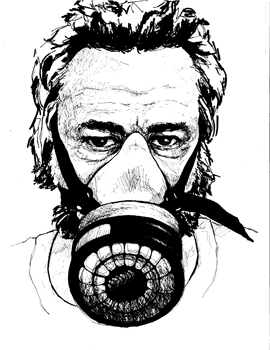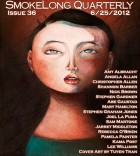This story feels like magic to me. For example, the way you mention the farmer and his horse, and suddenly the horse is real, stumbling around in your forest. It makes me want to read your collection, and I’m curious: is this typical of your story-telling style?
Thanks! I think I definitely like to take mostly real situations and give them some sort of twist that makes them a little surreal. For this story, I had this picture in my mind of a headless horse bumbling through the woods and the rest followed. Other stories have been like that, too, where I have a single line or image that just doesn’t leave my brain until I get the rest of the story written down. Usually that line or image is something a little weird.
I would love to better understand the story’s title in relation to the story. Can you say how you arrived at it and what it means to you?
The title was there from the beginning and sort of leads the feeling of the piece for me. On one hand, I had an image of a headless horse, and I knew that was going to be a story. I also had an idea for a story about a boy living in a cave (inspired by Saint Drogo, patron saint of ugly people). So the title was always tied to the story of the boy. For me it’s a big part of the ugly/pretty of the story.
The theme of deception runs through this, but it feels complicated. Who is deceiving whom?
I think the main deception is to the self. I don’t really know how to put it, but I guess the more dirt you put out in the world, the more dirt you put on yourself. I don’t know, I can’t really convey what I’m thinking about that idea. In this story though, I think the only person (or animal) who isn’t lying is Walter. Actually, in earlier versions of the story he talks a bit about the lies all around him.
Who are your favorite flash writers? Or writers in general?
This story was heavily influenced by Dylan Thomas. Particularly his story “The Dress,” which is my favorite story of all time. I was kind of trying to give that story a polite curtsy.
Can you describe the space where you write?
I walk to work and I need to get the story figured out in my mind before I can start typing at all. By the time I hit the computer, I have most of it figured out already. So I guess I would say Hollywood/Sunset Blvd. between Normandie and Santa Monica. (And I usually sit down to write at the kitchen table.)



 The core workshop of SmokeLong Fitness is all in writing, so you can take part from anywhere at anytime. We are excited about creating a supportive, consistent and structured environment for flash writers to work on their craft in a community. We are thrilled and proud to say that our workshop participants have won, placed, or been listed in every major flash competition. Community works.
The core workshop of SmokeLong Fitness is all in writing, so you can take part from anywhere at anytime. We are excited about creating a supportive, consistent and structured environment for flash writers to work on their craft in a community. We are thrilled and proud to say that our workshop participants have won, placed, or been listed in every major flash competition. Community works.